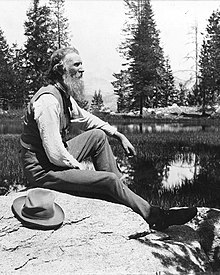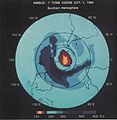Portal:Environment: Difference between revisions
No edit summary Tag: Reverted |
Added Information Tags: Reverted Visual edit |
||
| Line 1: | Line 1: | ||
{{Portal maintenance status|date=June 2018|subpages=keep}} |
The issue of Environment{{Portal maintenance status|date=June 2018|subpages=keep}} |
||
{{Portal description|the environment}} |
{{Portal description|the environment}} |
||
<small>{{Portals browsebar}}</small>__NOTOC__ |
<small>{{Portals browsebar}}</small>__NOTOC__ |
||
{{/Tabbed header}} |
{{/Tabbed header}} |
||
{{/Header}} |
{{/Header}} |
||
{| width="100%" cellpadding="5" cellspacing="5" style="background:#BCD982; border-style:ridge; border-width:2px; border-color: #A6BF73" |
{| class="wikitable" width="100%" cellpadding="5" cellspacing="5" style="background:#BCD982; border-style:ridge; border-width:2px; border-color: #A6BF73" |
||
| width="55%" style="vertical-align:top;padding: 0; margin:0;" | |
| width="55%" style="vertical-align:top;padding: 0; margin:0;" | |
||
<div style="width:100%"> |
<div style="width:100%"> |
||
Revision as of 23:45, 26 November 2020
The issue of Environment
Introduction The natural environment or natural world encompasses all biotic and abiotic things occurring naturally, meaning in this case not artificial. The term is most often applied to Earth or some parts of Earth. This environment encompasses the interaction of all living species, climate, weather and natural resources that affect human survival and economic activity. The concept of the natural environment can be distinguished as components:
In contrast to the natural environment is the built environment. Built environments are where humans have fundamentally transformed landscapes such as urban settings and agricultural land conversion, the natural environment is greatly changed into a simplified human environment. Even acts which seem less extreme, such as building a mud hut or a photovoltaic system in the desert, the modified environment becomes an artificial one. Though many animals build things to provide a better environment for themselves, they are not human, hence beaver dams, and the works of mound-building termites, are thought of as natural. People cannot find absolutely natural environments on Earth, and naturalness usually varies in a continuum, from 100% natural in one extreme to 0% natural in the other. The massive environmental changes of humanity in the Anthropocene have fundamentally effected all natural environments: including from climate change, biodiversity loss and pollution from plastic and other chemicals in the air and water. More precisely, we can consider the different aspects or components of an environment, and see that their degree of naturalness is not uniform. If, for instance, in an agricultural field, the mineralogic composition and the structure of its soil are similar to those of an undisturbed forest soil, but the structure is quite different. (Full article...)  The natural environment or natural world encompasses all biotic and abiotic things occurring naturally, meaning in this case not artificial. The term is most often applied to Earth or some parts of Earth. This environment encompasses the interaction of all living species, climate, weather and natural resources that affect human survival and economic activity. The concept of the natural environment can be distinguished as components:
In contrast to the natural environment is the built environment. Built environments are where humans have fundamentally transformed landscapes such as urban settings and agricultural land conversion, the natural environment is greatly changed into a simplified human environment. Even acts which seem less extreme, such as building a mud hut or a photovoltaic system in the desert, the modified environment becomes an artificial one. Though many animals build things to provide a better environment for themselves, they are not human, hence beaver dams, and the works of mound-building termites, are thought of as natural. People cannot find absolutely natural environments on Earth, and naturalness usually varies in a continuum, from 100% natural in one extreme to 0% natural in the other. The massive environmental changes of humanity in the Anthropocene have fundamentally effected all natural environments: including from climate change, biodiversity loss and pollution from plastic and other chemicals in the air and water. More precisely, we can consider the different aspects or components of an environment, and see that their degree of naturalness is not uniform. If, for instance, in an agricultural field, the mineralogic composition and the structure of its soil are similar to those of an undisturbed forest soil, but the structure is quite different. (Full article...) Selected article -Seacology is a nonprofit 501(c)(3) charitable organization headquartered in Berkeley, California, that works to preserve island ecosystems and cultures around the world. Founded in 1991, it began with the work of ethnobotanist Paul Alan Cox, who researched tropical plants and their medicinal value in the village of Falealupo in Samoa during the mid-1980s. When the villagers were pressured into selling logging rights to their rainforest in 1988 to build a new school, Cox and his wife offered to help secure funds for the new school in return for an agreement with the villagers to protect their forest. With the help of his friends and family, Cox secured the funds within six months, later earning him and the village chief, Fuiono Senio, the Goldman Environmental Prize for their efforts. Word spread throughout the islands, and with increasing demand for similar projects, Cox, along with Bill Marré and Ken Murdock, decided to form Seacology and expand their work internationally. For the first few years, the organization operated on a volunteer basis. Because of the high risk of extinction for island fauna and the decline in coral reef ecosystems, Seacology's primary focus is projects in which villagers sign contracts under which they agree to help protect either terrestrial or marine habitat for a specified time in return for new buildings or services. The operations are low-cost, averaging around US$20,000 to $25,000. Construction is done with local labor and sometimes without the use of machinery. Seacology selects its projects by reviewing the recommendations of its field representatives and its scientific advisory board. (Full article...)Did you know -
Selected image - A false-color composite of global oceanic and terrestrial photoautotroph abundance, from September 1997 to August 2000. The picture shows the activity of photosynthesizing organisms in the biosphere. Many of these are used for ecosystem services which are natural processes relied upon by humans. Current events
Selected biography -John Muir (/mjʊər/ MURE; April 21, 1838 – December 24, 1914), also known as "John of the Mountains" and "Father of the National Parks", was a Scottish-born American naturalist, author, environmental philosopher, botanist, zoologist, glaciologist, and early advocate for the preservation of wilderness in the United States. His books, letters and essays describing his adventures in nature, especially in the Sierra Nevada, have been read by millions. His activism helped to preserve the Yosemite Valley and Sequoia National Park, and his example has served as an inspiration for the preservation of many other wilderness areas. The Sierra Club, which he co-founded, is a prominent American conservation organization. In his later life, Muir devoted most of his time to his wife and the preservation of the Western forests. As part of the campaign to make Yosemite a national park, Muir published two landmark articles on wilderness preservation in The Century Magazine, "The Treasures of the Yosemite" and "Features of the Proposed Yosemite National Park"; this helped support the push for US Congress to pass a bill in 1890 establishing Yosemite National Park. The spiritual quality and enthusiasm toward nature expressed in his writings has inspired readers, including presidents and congressmen, to take action to help preserve large nature areas. (Full article...)Selected organization -Greenpeace is an independent global campaigning network, founded in Canada in 1971 by a group of environmental activists. Greenpeace states its goal is to "ensure the ability of the Earth to nurture life in all its diversity" and focuses its campaigning on worldwide issues such as climate change, deforestation, overfishing, commercial whaling, genetic engineering, anti-war and anti-nuclear issues. It uses direct action, advocacy, research, and ecotage to achieve its goals. The network comprises 26 independent national/regional organisations in over 55 countries across Europe, the Americas, Africa, Asia, Australia and the Pacific, as well as a coordinating body, Greenpeace International, based in Amsterdam, the Netherlands. (Full article...)General imagesThe following are images from various environment-related articles on Wikipedia.
Selected quote -Main topicsRelated articlesThings you can do
Related categoriesRelated portalsWikiProjectsAssociated WikimediaThe following Wikimedia Foundation sister projects provide more on this subject:
Discover Wikipedia using portals |




































































